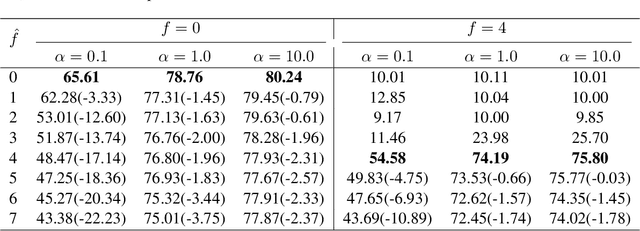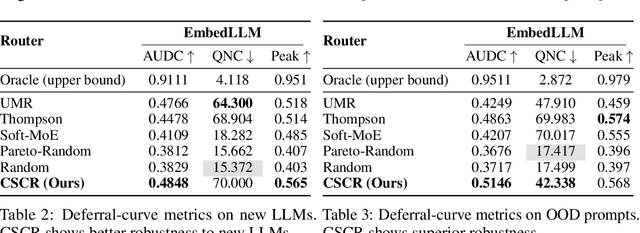Heng Huang
The University of Texas at Arlington
Explore Data Left Behind in Reinforcement Learning for Reasoning Language Models
Nov 06, 2025Abstract:Reinforcement Learning with Verifiable Rewards (RLVR) has emerged as an effective approach for improving the reasoning abilities of large language models (LLMs). The Group Relative Policy Optimization (GRPO) family has demonstrated strong performance in training LLMs with RLVR. However, as models train longer and scale larger, more training prompts become residual prompts, those with zero variance rewards that provide no training signal. Consequently, fewer prompts contribute to training, reducing diversity and hindering effectiveness. To fully exploit these residual prompts, we propose the Explore Residual Prompts in Policy Optimization (ERPO) framework, which encourages exploration on residual prompts and reactivates their training signals. ERPO maintains a history tracker for each prompt and adaptively increases the sampling temperature for residual prompts that previously produced all correct responses. This encourages the model to generate more diverse reasoning traces, introducing incorrect responses that revive training signals. Empirical results on the Qwen2.5 series demonstrate that ERPO consistently surpasses strong baselines across multiple mathematical reasoning benchmarks.
Trade-off in Estimating the Number of Byzantine Clients in Federated Learning
Oct 06, 2025



Abstract:Federated learning has attracted increasing attention at recent large-scale optimization and machine learning research and applications, but is also vulnerable to Byzantine clients that can send any erroneous signals. Robust aggregators are commonly used to resist Byzantine clients. This usually requires to estimate the unknown number $f$ of Byzantine clients, and thus accordingly select the aggregators with proper degree of robustness (i.e., the maximum number $\hat{f}$ of Byzantine clients allowed by the aggregator). Such an estimation should have important effect on the performance, which has not been systematically studied to our knowledge. This work will fill in the gap by theoretically analyzing the worst-case error of aggregators as well as its induced federated learning algorithm for any cases of $\hat{f}$ and $f$. Specifically, we will show that underestimation ($\hat{f}<f$) can lead to arbitrarily poor performance for both aggregators and federated learning. For non-underestimation ($\hat{f}\ge f$), we have proved optimal lower and upper bounds of the same order on the errors of both aggregators and federated learning. All these optimal bounds are proportional to $\hat{f}/(n-f-\hat{f})$ with $n$ clients, which monotonically increases with larger $\hat{f}$. This indicates a fundamental trade-off: while an aggregator with a larger robustness degree $\hat{f}$ can solve federated learning problems of wider range $f\in [0,\hat{f}]$, the performance can deteriorate when there are actually fewer or even no Byzantine clients (i.e., $f\in [0,\hat{f})$).
Zeroth-Order Methods for Stochastic Nonconvex Nonsmooth Composite Optimization
Oct 06, 2025Abstract:This work aims to solve a stochastic nonconvex nonsmooth composite optimization problem. Previous works on composite optimization problem requires the major part to satisfy Lipschitz smoothness or some relaxed smoothness conditions, which excludes some machine learning examples such as regularized ReLU network and sparse support matrix machine. In this work, we focus on stochastic nonconvex composite optimization problem without any smoothness assumptions. In particular, we propose two new notions of approximate stationary points for such optimization problem and obtain finite-time convergence results of two zeroth-order algorithms to these two approximate stationary points respectively. Finally, we demonstrate that these algorithms are effective using numerical experiments.
Achieve Performatively Optimal Policy for Performative Reinforcement Learning
Oct 06, 2025
Abstract:Performative reinforcement learning is an emerging dynamical decision making framework, which extends reinforcement learning to the common applications where the agent's policy can change the environmental dynamics. Existing works on performative reinforcement learning only aim at a performatively stable (PS) policy that maximizes an approximate value function. However, there is a provably positive constant gap between the PS policy and the desired performatively optimal (PO) policy that maximizes the original value function. In contrast, this work proposes a zeroth-order Frank-Wolfe algorithm (0-FW) algorithm with a zeroth-order approximation of the performative policy gradient in the Frank-Wolfe framework, and obtains \textbf{the first polynomial-time convergence to the desired PO} policy under the standard regularizer dominance condition. For the convergence analysis, we prove two important properties of the nonconvex value function. First, when the policy regularizer dominates the environmental shift, the value function satisfies a certain gradient dominance property, so that any stationary point (not PS) of the value function is a desired PO. Second, though the value function has unbounded gradient, we prove that all the sufficiently stationary points lie in a convex and compact policy subspace $\Pi_{\Delta}$, where the policy value has a constant lower bound $\Delta>0$ and thus the gradient becomes bounded and Lipschitz continuous. Experimental results also demonstrate that our 0-FW algorithm is more effective than the existing algorithms in finding the desired PO policy.
Parallel-R1: Towards Parallel Thinking via Reinforcement Learning
Sep 09, 2025Abstract:Parallel thinking has emerged as a novel approach for enhancing the reasoning capabilities of large language models (LLMs) by exploring multiple reasoning paths concurrently. However, activating such capabilities through training remains challenging, as existing methods predominantly rely on supervised fine-tuning (SFT) over synthetic data, which encourages teacher-forced imitation rather than exploration and generalization. Different from them, we propose \textbf{Parallel-R1}, the first reinforcement learning (RL) framework that enables parallel thinking behaviors for complex real-world reasoning tasks. Our framework employs a progressive curriculum that explicitly addresses the cold-start problem in training parallel thinking with RL. We first use SFT on prompt-generated trajectories from easier tasks to instill the parallel thinking ability, then transition to RL to explore and generalize this skill on harder problems. Experiments on various math benchmarks, including MATH, AMC23, and AIME, show that Parallel-R1 successfully instills parallel thinking, leading to 8.4% accuracy improvements over the sequential thinking model trained directly on challenging tasks with RL. Further analysis reveals a clear shift in the model's thinking behavior: at an early stage, it uses parallel thinking as an exploration strategy, while in a later stage, it uses the same capability for multi-perspective verification. Most significantly, we validate parallel thinking as a \textbf{mid-training exploration scaffold}, where this temporary exploratory phase unlocks a higher performance ceiling after RL, yielding a 42.9% improvement over the baseline on AIME25. Our model, data, and code will be open-source at https://github.com/zhengkid/Parallel-R1.
Rectified Robust Policy Optimization for Model-Uncertain Constrained Reinforcement Learning without Strong Duality
Aug 24, 2025



Abstract:The goal of robust constrained reinforcement learning (RL) is to optimize an agent's performance under the worst-case model uncertainty while satisfying safety or resource constraints. In this paper, we demonstrate that strong duality does not generally hold in robust constrained RL, indicating that traditional primal-dual methods may fail to find optimal feasible policies. To overcome this limitation, we propose a novel primal-only algorithm called Rectified Robust Policy Optimization (RRPO), which operates directly on the primal problem without relying on dual formulations. We provide theoretical convergence guarantees under mild regularity assumptions, showing convergence to an approximately optimal feasible policy with iteration complexity matching the best-known lower bound when the uncertainty set diameter is controlled in a specific level. Empirical results in a grid-world environment validate the effectiveness of our approach, demonstrating that RRPO achieves robust and safe performance under model uncertainties while the non-robust method can violate the worst-case safety constraints.
Cost-Aware Contrastive Routing for LLMs
Aug 17, 2025



Abstract:We study cost-aware routing for large language models across diverse and dynamic pools of models. Existing approaches often overlook prompt-specific context, rely on expensive model profiling, assume a fixed set of experts, or use inefficient trial-and-error strategies. We introduce Cost-Spectrum Contrastive Routing (CSCR), a lightweight framework that maps both prompts and models into a shared embedding space to enable fast, cost-sensitive selection. CSCR uses compact, fast-to-compute logit footprints for open-source models and perplexity fingerprints for black-box APIs. A contrastive encoder is trained to favor the cheapest accurate expert within adaptive cost bands. At inference time, routing reduces to a single k-NN lookup via a FAISS index, requiring no retraining when the expert pool changes and enabling microsecond latency. Across multiple benchmarks, CSCR consistently outperforms baselines, improving the accuracy-cost tradeoff by up to 25%, while generalizing robustly to unseen LLMs and out-of-distribution prompts.
A Watermark for Auto-Regressive Image Generation Models
Jun 13, 2025



Abstract:The rapid evolution of image generation models has revolutionized visual content creation, enabling the synthesis of highly realistic and contextually accurate images for diverse applications. However, the potential for misuse, such as deepfake generation, image based phishing attacks, and fabrication of misleading visual evidence, underscores the need for robust authenticity verification mechanisms. While traditional statistical watermarking techniques have proven effective for autoregressive language models, their direct adaptation to image generation models encounters significant challenges due to a phenomenon we term retokenization mismatch, a disparity between original and retokenized sequences during the image generation process. To overcome this limitation, we propose C-reweight, a novel, distortion-free watermarking method explicitly designed for image generation models. By leveraging a clustering-based strategy that treats tokens within the same cluster equivalently, C-reweight mitigates retokenization mismatch while preserving image fidelity. Extensive evaluations on leading image generation platforms reveal that C-reweight not only maintains the visual quality of generated images but also improves detectability over existing distortion-free watermarking techniques, setting a new standard for secure and trustworthy image synthesis.
ARGUS: Hallucination and Omission Evaluation in Video-LLMs
Jun 09, 2025Abstract:Video large language models have not yet been widely deployed, largely due to their tendency to hallucinate. Typical benchmarks for Video-LLMs rely simply on multiple-choice questions. Unfortunately, VideoLLMs hallucinate far more aggressively on freeform text generation tasks like video captioning than they do on multiple choice verification tasks. To address this weakness, we propose ARGUS, a VideoLLM benchmark that measures freeform video captioning performance. By comparing VideoLLM outputs to human ground truth captions, ARGUS quantifies dual metrics. First, we measure the rate of hallucinations in the form of incorrect statements about video content or temporal relationships. Second, we measure the rate at which the model omits important descriptive details. Together, these dual metrics form a comprehensive view of video captioning performance.
CoTGuard: Using Chain-of-Thought Triggering for Copyright Protection in Multi-Agent LLM Systems
May 26, 2025Abstract:As large language models (LLMs) evolve into autonomous agents capable of collaborative reasoning and task execution, multi-agent LLM systems have emerged as a powerful paradigm for solving complex problems. However, these systems pose new challenges for copyright protection, particularly when sensitive or copyrighted content is inadvertently recalled through inter-agent communication and reasoning. Existing protection techniques primarily focus on detecting content in final outputs, overlooking the richer, more revealing reasoning processes within the agents themselves. In this paper, we introduce CoTGuard, a novel framework for copyright protection that leverages trigger-based detection within Chain-of-Thought (CoT) reasoning. Specifically, we can activate specific CoT segments and monitor intermediate reasoning steps for unauthorized content reproduction by embedding specific trigger queries into agent prompts. This approach enables fine-grained, interpretable detection of copyright violations in collaborative agent scenarios. We evaluate CoTGuard on various benchmarks in extensive experiments and show that it effectively uncovers content leakage with minimal interference to task performance. Our findings suggest that reasoning-level monitoring offers a promising direction for safeguarding intellectual property in LLM-based agent systems.
 Add to Chrome
Add to Chrome Add to Firefox
Add to Firefox Add to Edge
Add to Edge